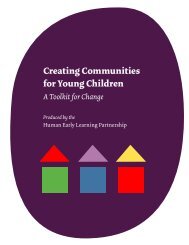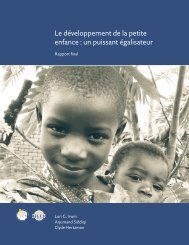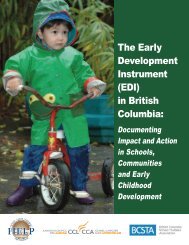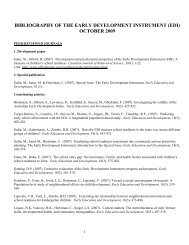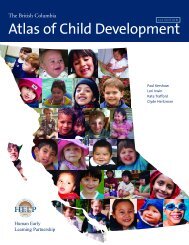Total Environment Assessment Model for Early Child Development
Total Environment Assessment Model for Early Child Development
Total Environment Assessment Model for Early Child Development
You also want an ePaper? Increase the reach of your titles
YUMPU automatically turns print PDFs into web optimized ePapers that Google loves.
Executive<br />
Summary<br />
knowledge is required in order to understand<br />
how regional characteristics can be modified<br />
to positively influence ecd.<br />
The most salient feature of the national<br />
environment is its capacity to affect<br />
multiple determinants of ecd through<br />
wealth creation, public spending, child- and<br />
family-friendly policies, social protection<br />
and protection of basic rights. The chances<br />
that children will face extreme poverty, child<br />
labour, warfare, hiv/aids, being left in<br />
the care of a sibling, is determined, first and<br />
<strong>for</strong>emost, by the countries in which they are<br />
born.<br />
At the level of the national environment,<br />
comprehensive, inter-sectoral approaches<br />
to policy and decision-making work best <strong>for</strong><br />
ecd. Although ecd outcomes tend to be<br />
more favourable in wealthy countries than<br />
poor ones, this is not always the case. It is<br />
clear that a commitment of 1.5–2.0% of gdp<br />
to an effective mix of policies and programs<br />
in the public sector can effectively support<br />
children’s early development. Those nations<br />
with less economic and political power are<br />
less free to determine their internal policy<br />
agendas, and are more influenced by the<br />
interests of the international community,<br />
including other nations and multilateral<br />
organizations. Notwithstanding this, most of<br />
the recommendations in this report are within<br />
the capabilities of any national government<br />
that meets the international criteria <strong>for</strong> a<br />
“competent authority.”<br />
The global environment can influence<br />
ecd through its effects on the policies of<br />
nations as well as through the direct actions of<br />
a range of relevant actors, including multilateral<br />
economic organizations, industry,<br />
multilateral development agencies, non-governmental<br />
development agencies, and civil<br />
society groups. A major feature of the global<br />
environment in relation to children’s wellbeing<br />
is the element of power in economic,<br />
social, and political terms. Power differentials<br />
between types of actors, particularly<br />
between nations, have many consequences,<br />
including the ability of some nations (mainly<br />
resource-rich ones) to influence the policies<br />
of other nations (mainly resource-poor ones)<br />
to suit their own interests. Although power<br />
differentials may have invidious effects on<br />
ecd, they can be exploited <strong>for</strong> the benefit of<br />
children, too. Requiring a minimum level of<br />
government spending on ecd and compliance<br />
with the Rights in <strong>Early</strong> <strong>Child</strong>hood provisions<br />
of the Convention on the Rights of the <strong>Child</strong><br />
(uncrc), as pre-conditions <strong>for</strong> international<br />
developmental assistance, are two mechanisms<br />
that can be used. Analogous mechanisms<br />
have been used effectively in other areas of<br />
international development in the past.<br />
Civil society groups are conceptualized<br />
as being organized at, and acting on, all levels<br />
of social organization, from local residential<br />
through global. The ability of civil society<br />
to act on behalf of children is a function of<br />
the extent of “social capital,” or connectedness<br />
of citizens, and the support of political<br />
institutions in promoting expressions of civil<br />
organization. When civil society is enabled,<br />
there are many avenues through which they<br />
can engage on behalf of children. Civil society<br />
groups can initiate government, non-government<br />
organization, and community action<br />
on social determinants of ecd. They can<br />
advocate on behalf of children to assure that<br />
governments and international agencies adopt<br />
policies that positively benefit children’s<br />
well-being. Finally, civil society groups are<br />
instrumental in organizing strategies at the<br />
local level to provide families and children<br />
with effective delivery of ecd services, to<br />
improve the safety, cohesion, and efficacy of<br />
residential environments, and to increase the<br />
capacity of local and relational communities<br />
to better the lives of children. Although<br />
research on the direct effect of civil society on<br />
ecd is limited, the strong statistical association<br />
between the strength of civil society and<br />
human development in societies around the<br />
globe leaves little doubt about its importance<br />
to ecd.



